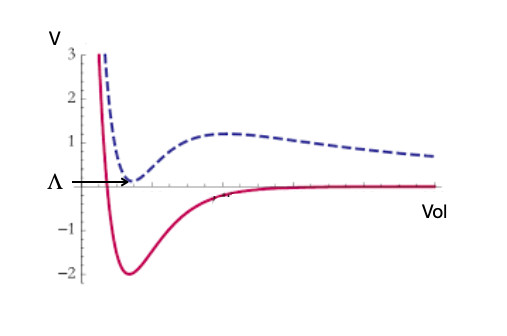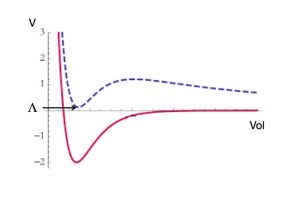
Caption: The string theory solution is a product of a four-dimensional universe times a small six-dimensional space. The cosmological constant (Λ) is the minimum value of the potential energy, here plotted as a function of the volume of the six-dimensional manifold. The cosmological constant before the “uplifting” (red curve) is negative, while after it (blue curve) is positive and tiny, as that of our universe.
Experiments reveal that our universe has an accelerating expansion, which, in the context of general relativity, requires the positivity of Einstein's cosmological constant. A positive cosmological constant poses several problems in the context of quantum gravitational theories. String theory, one of the most developed theories of quantum gravity, has been struggling to find solutions of the equations of motion that include a four-dimensional space with positive cosmological constant.
The proposals available so far involve a mixture of mechanisms at different energy scales, whose interplay is not clear to result in energetically stable solutions. Furthermore, they remain technically challenging, as one needs to introduce a combination of the so called “fluxes” (higher-dimensional generalizations of the electromagnetic flux) tuned “ad hoc” to give unnaturally tiny contributions to the energy of the solution.
In a recent work [1], Iosif Bena and Mariana Graña of the IPhT, together with their student Dimitrios Tulikas, their post-doc Gabriele Lo Monaco, as well as their collaborator E. Dudas (CPHT, Ecole Polytechnique), have found a much more straightforward “bare-bones” way of obtaining a solution with a positive cosmological constant, that does not require introducing such fine-tuned fluxes. Indeed, they have shown that one of the ingredients necessary in the game to uplift the cosmological constant from the negative value (that one gets easily) to a positive one, generates by itself fluxes resulting in a tiny energetic contribution. This construction is much more natural and avoids the fine-tuning problem of the original one, thus elegantly passing the “naturalness test”.


